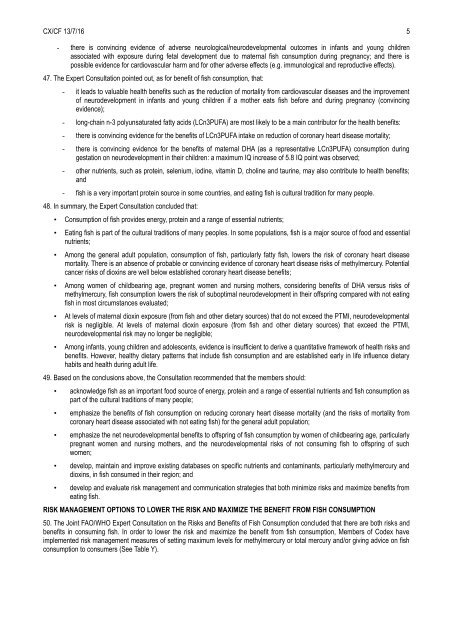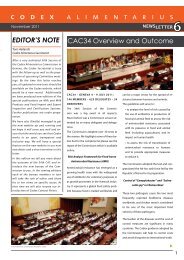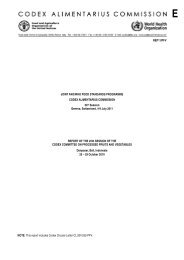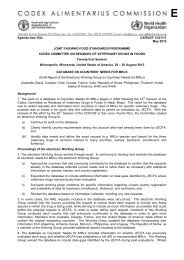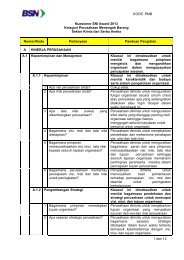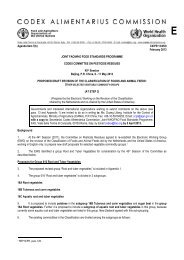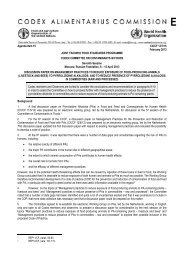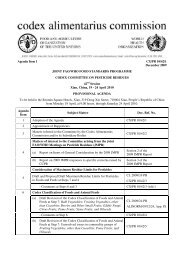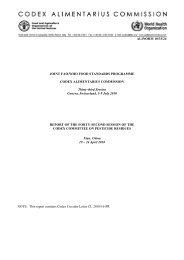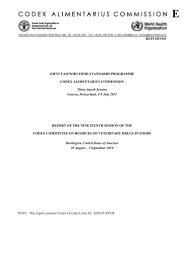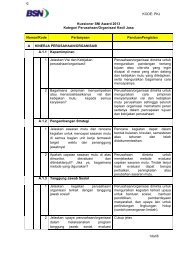<strong>CX</strong>/<strong>CF</strong> <strong>13</strong>/7/<strong>16</strong> 4ANALYTICAL METHODS29. The review of the GLs for methylmercury in fish should be based on scientifically sound occurrence data obtained usinganalytical methods validated in accordance with the internationally harmonized protocols 6 .30. In determining total mercury in fish, cold vapor flameless atomic absorption spectrophotometory (CV-AAS) methods and rapidmethods with direct mercury analyzers (an automated AAS which can determine total mercury in a test portion without any chemicalpretreatment) are usually used. In CV-AAS methods, all chemical forms of mercury are converted into mercury(II) ion by digestion ofa test portion (fish sample) with such mineral acid as nitric acid or sulfuric acid, and sometimes with additional oxidizing reagent.Mercury(II) ion is then reduced to elemental mercury by addition of reducing reagent such as tin(II) chloride. The elemental mercuryvapor at room temperature is introduced into an absorption cell and the absorption at 253.7 nm is measured for determination. InCodex, AOAC 977.15, CV-AAS method, has been endorsed as a Type III method for the determination of total mercury in fish andfishery products (CODEX STAN 234-1999). Other CV-AAS methods, such as AOAC 971.21, and AOAC 974.14, are available.40. Analytical methods for methylmercury in fish involve the extraction of methylmercury. Two types of extraction, hydrochloric acidleaching extraction and dithizone (diphenylthiocarbazone) extraction, have been widely used. In the hydrochloric acid leachingextraction, methylmercury in a test portion is extracted with <strong>org</strong>anic solvent such as benzene or toluene, followed by acidification toits halide, back-extraction into an aqueous solution of cysteine or glutathione, and re-extraction into an <strong>org</strong>anic solvent. If necessary,the <strong>org</strong>anic extract is dehydrated by addition of disodium sulfonate anhydride. In the dithizone extraction, a test portion isdecomposed under alkaline conditions and methylmercury is extracted with a dithizone-toluene solution as its dithizonate, followedby back-extraction into alkaline sodium sulfide and dithizone re-extraction. Recently, extraction without using benzene or toluene isalso used: methylmercury in a test portion is extracted with an aqueous solution of cysteine and HCl, or of cysteine, HCl andmercaptoethanol, without subsequent extraction with <strong>org</strong>anic solvents. The aqueous extract is then injected into a gaschromatograph (GC) or liquid chromatograph (LC) for separation and methylmercury is detected by electron capture detector (ECD),atomic fluorescence spectrophotometers (AFS), inductively coupled plasma-mass spectrometry (ICP-MS), or any other appropriatedetector. The methylmercury concentration in a test portion is determined by comparing the average peak heights of test solution tothose of standard solutions.41. Analytical methods available for determining methylmercury in biological and environmental samples have been extensivelyreviewed in several articles (8, 9). In 2005, more than ten analytical methods, which were state-of-the-art at that time, werecompared within the framework of the International Committee for Weights and Measures (CIPM) Pilot Study <strong>org</strong>anized by theInstitute for Reference Materials and Measurements (IRMM) (10). Additionally, the IRMM is currently undertaking the inter-laboratorycomparison for the validation (collaborative trial) of a method for the determination of methylmercury in seafood 7 . This methodemploys a double liquid-liquid extraction, first with an <strong>org</strong>anic solvent and second with a cysteine solution, and the quantification witha direct mercury analyzer. The National Institute of Nutrition and Seafood Research of Norway is also undertaking a collaborativetrial of a method for the determination of methylmercury in seafood using GC-ICP-MS, joined by 11 laboratories in Europe. The trialis expected to complete by the end of 2012, and the result would be available in 20<strong>13</strong>.42. In Codex, AOAC 988.11 has been endorsed as the Type II method for the determination of methylmercury in fish (CODEX STAN234-1999). Other internationally validated analytical methods, such as AOAC 990.04, are also applicable to fish and fishery products.Table X provides the summary of the principles and performance characteristics of these methods.43. At the national level, various analytical methods are also used for routine food control or monitoring purposes (See Table XX).44. In reviewing the guideline levels for methylmercury in fish and predatory fish, appropriate analytical methods for regulatorypurposes should also be considered. As seen above, there are currently many, potentially newer, analytical methods used by CodexMembers for the determination of methylmercury in fish, in addition to internationally validated methods. As science develops rapidlyin the area of analytical methods including those for the determination of methylmercury in fish, an established list of specificmethods may become out of date in the near future. Under these circumstances, using the criteria approach is recommended forconsideration in accordance with the Codex general method principles and performance criteria (General Criteria) 8 rather thanprescribing specific analytical methods.SUMMARY OF OUTCOME OF THE <strong>JOINT</strong> <strong>FAO</strong>/WHO EXPERT CONSULTATION ON THE RISKS AND BENEFITS OF FISHCONSUMPTION45. The Joint <strong>FAO</strong>/WHO Expert Consultation on the Risks and Benefits of Fish Consumption (25 to 29 January 2010) was convenedto review data on levels of nutrients, methylmercury and dioxin in fish, and epidemiological data, and to carry out risk-benefitassessments on fish consumption.46. The Expert Consultation reached several conclusions on risks associated with exposure to methylmercury in fish, such as:6CAC/GL 28-1995 recommends to use the following Protocol for quality assurance of food control laboratories: “Protocol for the Design, Conductand Interpretation of Method Performance Studies”, Pure & Appl. Chem., 65 (1995) 2<strong>13</strong>2-2144 and J. AOAC International, 76 (1993) 926-940.7The IRMM website:http://irmm.jrc.ec.europa.eu/EURLs/EURL_heavy_metals/interlaboratory_comparisons/Pages/IMEP-115Determinationofmethylmercuryinseafood.aspx8The Principles for the Establishment of Codex Methods of Analysis section in the Codex Alimentarius Commission PROCEDURAL MANUAL,20th ed. Document.
<strong>CX</strong>/<strong>CF</strong> <strong>13</strong>/7/<strong>16</strong> 5- there is convincing evidence of adverse neurological/neurodevelopmental outcomes in infants and young childrenassociated with exposure during fetal development due to maternal fish consumption during pregnancy; and there ispossible evidence for cardiovascular harm and for other adverse effects (e.g. immunological and reproductive effects).47. The Expert Consultation pointed out, as for benefit of fish consumption, that:- it leads to valuable health benefits such as the reduction of mortality from cardiovascular diseases and the improvementof neurodevelopment in infants and young children if a mother eats fish before and during pregnancy (convincingevidence);- long-chain n-3 polyunsaturated fatty acids (LCn3PUFA) are most likely to be a main contributor for the health benefits:- there is convincing evidence for the benefits of LCn3PUFA intake on reduction of coronary heart disease mortality;- there is convincing evidence for the benefits of maternal DHA (as a representative LCn3PUFA) consumption duringgestation on neurodevelopment in their children: a maximum IQ increase of 5.8 IQ point was observed;- other nutrients, such as protein, selenium, iodine, vitamin D, choline and taurine, may also contribute to health benefits;and- fish is a very important protein source in some countries, and eating fish is cultural tradition for many people.48. In summary, the Expert Consultation concluded that:• Consumption of fish provides energy, protein and a range of essential nutrients;• Eating fish is part of the cultural traditions of many peoples. In some populations, fish is a major source of food and essentialnutrients;• Among the general adult population, consumption of fish, particularly fatty fish, lowers the risk of coronary heart diseasemortality. There is an absence of probable or convincing evidence of coronary heart disease risks of methylmercury. Potentialcancer risks of dioxins are well below established coronary heart disease benefits;• Among women of childbearing age, pregnant women and nursing mothers, considering benefits of DHA versus risks ofmethylmercury, fish consumption lowers the risk of suboptimal neurodevelopment in their offspring compared with not eatingfish in most circumstances evaluated;• At levels of maternal dioxin exposure (from fish and other dietary sources) that do not exceed the PTMI, neurodevelopmentalrisk is negligible. At levels of maternal dioxin exposure (from fish and other dietary sources) that exceed the PTMI,neurodevelopmental risk may no longer be negligible;• Among infants, young children and adolescents, evidence is insufficient to derive a quantitative framework of health risks andbenefits. However, healthy dietary patterns that include fish consumption and are established early in life influence dietaryhabits and health during adult life.49. Based on the conclusions above, the Consultation recommended that the members should:• acknowledge fish as an important food source of energy, protein and a range of essential nutrients and fish consumption aspart of the cultural traditions of many people;• emphasize the benefits of fish consumption on reducing coronary heart disease mortality (and the risks of mortality fromcoronary heart disease associated with not eating fish) for the general adult population;• emphasize the net neurodevelopmental benefits to offspring of fish consumption by women of childbearing age, particularlypregnant women and nursing mothers, and the neurodevelopmental risks of not consuming fish to offspring of suchwomen;• develop, maintain and improve existing databases on specific nutrients and contaminants, particularly methylmercury anddioxins, in fish consumed in their region; and• develop and evaluate risk management and communication strategies that both minimize risks and maximize benefits fromeating fish.RISK MANAGEMENT OPTIONS TO LOWER THE RISK AND MAXIMIZE THE BENEFIT FROM FISH CONSUMPTION50. The Joint <strong>FAO</strong>/WHO Expert Consultation on the Risks and Benefits of Fish Consumption concluded that there are both risks andbenefits in consuming fish. In order to lower the risk and maximize the benefit from fish consumption, Members of Codex haveimplemented risk management measures of setting maximum levels for methylmercury or total mercury and/or giving advice on fishconsumption to consumers (See Table Y).


